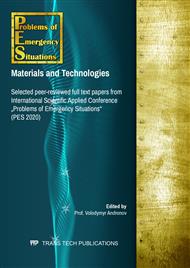[1]
B.B. Ward, D.J. Arp, M.G. Klotz, Nitrification, American Society for Microbiology. DC, USA, Washington. (2011).
Google Scholar
[2]
B. Veuger, A. Pitcher, S. Schouten, J. S. Sinninghe Damste´ and J. J. Middelburg, Nitrification and growth of autotrophic nitrifying bacteria and Thaumarchaeota in the coastal North Sea, Biogeosciences. 10 (2013) 1775–1785. www.biogeosciences.net/10/1775/2013/.
DOI: 10.5194/bg-10-1775-2013
Google Scholar
[3]
K.M. Lancaster, J.D. Caranto, S.H. Majer and M.A. Smith, Updates to and Challenges in Nitrification Metalloenzymology Joule, Alternative Bioenergy. 2 (2018) 421–441.
DOI: 10.1016/j.joule.2018.01.018
Google Scholar
[4]
D.A. Stahl, J.R. de la Torre, Physiology and diversity of ammoniaoxidizing archaea, Annu. Rev. Microbiol. 66 (2012) 83–101.
DOI: 10.1146/annurev-micro-092611-150128
Google Scholar
[5]
A. N. Nozhevnikova, YU. V. Litti, G. M. Zubov, M. G. Zubov, Anammox bacteria in nature and ecobiotechnology, University Book, Moscow, (2017).
Google Scholar
[6]
T. Shiozaki, M. Ijichi, K. Isobe, F. Hashihama, K. Nakamura, M. Ehama, K. Hayashizaki, K. Takahashi, K. Hamasaki and K. Furuya, Nitrification and its influence on biogeochemical cycles from the equatorial Pacific to the Arctic Ocean, The ISME Journal, 10 (2016) 2184–2197. Access modehttps://www.nature.com/articles/ismej201618.
DOI: 10.1038/ismej.2016.18
Google Scholar
[7]
T.T. Huyen Le, J. Fettig, G. Meon, Kinetics and simulation of nitrification at various pH values of a polluted river in the tropics, Ecohydrology & Hydrobiology. 188 (2018) 1-12. https://doi.org/10.1016/j.ecohyd.201.
DOI: 10.1016/j.ecohyd.2018.06.006
Google Scholar
[8]
S.A. Carini, S.B. Joye, Nitrification in Mono Lake, California: Activity and community composition during contrasting hydrological regimes, Limnol. Oceanogr. 53(6) (2008) 2546–2557.
DOI: 10.4319/lo.2008.53.6.2546
Google Scholar
[9]
A.V. Ryzhakov, Kinetic characteristics of the transformation of nitrogen-containing compounds in natural water, Ecological chemistry. 21 (2) (2012) 117-124.
Google Scholar
[10]
Nitrate and Nitrite in Drinking: A Toxicological Review / Water California Environmental Protection Agency. Oakland, CA, USA, 2011. p.139–145. Rev/1: Revisions indicated with a vertical line in the left margin.WHO/SDE/WSH/07.01/16/Rev/1.
Google Scholar
[11]
N. Espejo-Herrera, P. CantorK., N. Malats, D.T. Silverman, A. Tardón, R. García-Closas, C. Serra, M. Kogevinas, C.M. Villanueva, Nitrate in drinking water and bladder cancer risk in spain, Environmental Research..137 (2015) 299–307.
DOI: 10.1016/j.envres.2014.10.034
Google Scholar
[12]
M.J. McGuire, N.I. Lieu, V.S. Pearthree, Using chlorite ion to control nitrification, Journal American Water Association. 91 (10) (1999) 52-62.
DOI: 10.1002/j.1551-8833.1999.tb08715.x
Google Scholar
[13]
List of methods for performing measurements (determinations) of the composition and properties of samples of environmental objects, emissions, wastes and discharges provisionally allowed for use by the State Inspectorate of Ukraine, approved by the Head of the State Environmental Inspectorate of Ukraine - Chief State Inspector of Ukraine for Environmental Protection on 01.03.(2013).
Google Scholar
[14]
V.О. Iurchenko, The development of scientific and technological foundations for the operation of sewage systems in the conditions of biochemical oxidation of inorganic compounds. diss ... Doctors of tech. Sciences, Kharkiv, (2007).
Google Scholar
[15]
A.S. Zlyvko, S.M. Chesnokova, T.A. Trifonova, Assessment of the maximum permissible impact on self-cleaning processes in the ecosystem of a small watercourse, Bulletin of the Samara Scientific Center of the Russian Academy of Sciences, 16, 1(4) (2014) 967-971.
Google Scholar
[16]
V.O. Iurchenko, E.B. Ugnenko, N.I. Sorochuk, О.G. Melnikovа, V. Gintas, Study of Treatment Efficiency of Wastewater Collected from the Surface of Roads by Natural Zeolite, TRANSBUD-2019 IOP Conf. Series: Materials Science and Engineering. 708 (2019) 012035 IOP Publishing.
DOI: 10.1088/1757-899x/708/1/012035
Google Scholar



